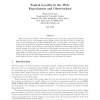Free Online Productivity Tools
i2Speak
i2Symbol
i2OCR
iTex2Img
iWeb2Print
iWeb2Shot
i2Type
iPdf2Split
iPdf2Merge
i2Bopomofo
i2Arabic
i2Style
i2Image
i2PDF
iLatex2Rtf
Sci2ools
SIGIR
2000
ACM
2000
ACM
Topical locality in the Web
Most web pages are linked to others with related content. This idea, combined with another that says that text in, and possibly around, HTML anchors describe the pages to which they point, is the foundation for a usable World-Wide Web. In this paper, we examine to what extent these ideas hold by empirically testing whether topical locality mirrors spatial locality of pages on the Web. In particular, we find that the likelihood of linked pages having similar textual content to be high; the similarity of sibling pages increases when the links from the parent are close together; titles, descriptions, and anchor text represent at least part of the target page; and that anchor text may be a useful discriminator among unseen child pages. These results present the foundations necessary for the success of many web systems, including search engines, focused crawlers, linkage analyzers, and intelligent web agents.
| Added | 01 Aug 2010 |
| Updated | 01 Aug 2010 |
| Type | Conference |
| Year | 2000 |
| Where | SIGIR |
| Authors | Brian D. Davison |
Comments (0)

